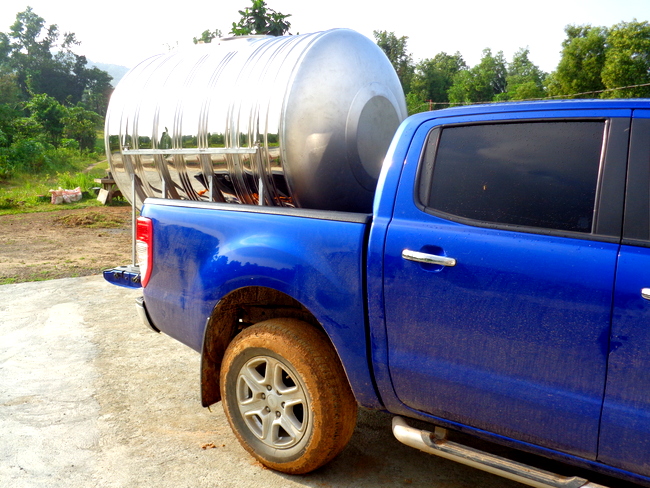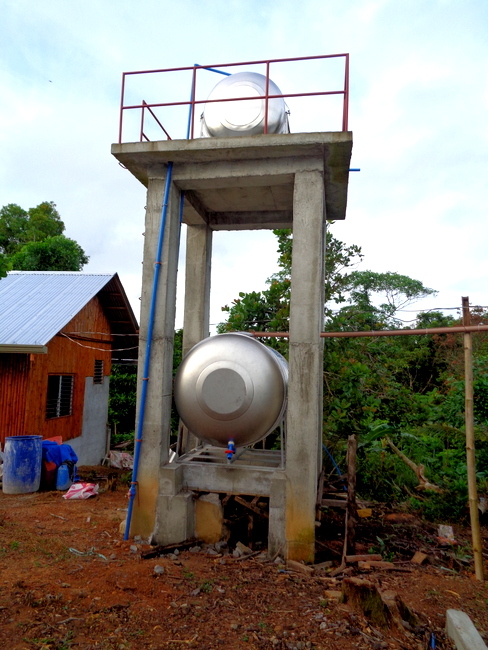Our water conservation project in the Philippines will recycle rainwater from our dirty kitchen roof along with one side of the roof from our new home. We’ve added a 2,000 liter stainless tank along with our former 1,000 liter tank in an effort to reduce the effects of the ongoing El Niño currently slamming the Philippines.
During the weather phenomenon known as El Niño, temperatures are higher than normal and rainfall is below normal.
The country will be feeling its full impact towards end of the year and early months of next year.
PAGASA said more than half of the country will suffer from the dry spell as it expects a substantial amount of reduced rainfall of about 60 to 80 percent.
According to the national weather service, this ongoing El Niño will be among the strongest, if not the strongest, to ever hit the Philippines.
(Source: CNN Philippines)
We hauled the new stainless steel, 2000-liter tank, from Jordan Wharf in Guimaras, the island province we call home in our Ford Ranger XLT. We purchased the tank from Super Agro Machinery in Iloilo City for 25,300 pesos, 540 US Dollars.
Thanks to our British friend, Keith, who recommended we check out Super Agro. We spoke to Super Agro’s owner, Gilbert, an extremely helpful young man, who gave us a good deal and took almost 7,000 pesos, 150 USD, off the list price.
It took four porters to unload the tank at Jordan.
It only took three people, my wife, brother-in-law Joery, and I to move it off the truck bed and place it on our terrace seen below.
It only two people, Joery and another helper, Jojo, to lift the tank to it’s eventual destination, beneath our present 1,000 water tank, as seen in the last photo.
Did I mention that each porter received a tip? We usually only have two porters that unload supplies for us from the pump boats at Jordan Wharf, but in their defense, they did have to lift the new tank up some fairly steep stairs from the banca boat’s deck.
The beginning stages of our water conservation project in the Philippines. JoJo was building a concrete support system to hold the new tank.
PVC pipe ran from the gutters of one side our roof and was connected to the gutters of our dirty kitchen.
The next picture reveals the length of the roof which will feed the new tank.

Here’s a closer look at the dirty kitchen connection. The dirty kitchen gutters will also feed into the tank.
The pvc pipe from the dirty kitchen and roof then will pour rain water into the new 2,000 liter tank shown below.
We use approximately 750 liters of water a day. We have four Comfort Rooms in our home and one CR in a nipa hut near the dirty kitchen. We have a total of seven people living at our residence on a daily basis not including visitors.
Here’s a shot of the 1,000 liter tank perched on top of the platform built months ago by our workers. A pump at this site feeds water from our 30-ft. well into the top 1,000 liter tank. A spigot placed on our new 2,000 liter water tank in the Philippines will made it handier to fill large blue plastic barrels, seen in the background.
We currently have 16 ft. of water in the well and the rainy season is rapidly coming to a close.
We hope this will help offset the need to haul in water after the rainy season is over. Our water delivery tankers charge 2,500 pesos for 10,000 liters, the equivalent of five 2,000 liter tanks such as the one we just purchased.
Let’s do the math:
2,000 liter stainless steel tank: 25,300 pesos
One delivery of water: 2,500 pesos.
We needed three tankfuls of water at our previous location at “The Farm” where we had two wells on site. We did not move into our new home in the Philippines until July of this year. The well had already been dug and the rainy season was in full swing.
But let’s say we need three tankfuls of water delivered during the summer months of April and May of next year. That will cost 7,500 pesos at this year’s rate.
Using three deliveries a year as an average, it would take over eight years to recoup the cost of the new water tank.
Is it worth the cost of the new tank?
I think so. Though we do not have the water shortage that Manila faces rains from the recent Typhoon Lando replenished the dams in Luzon but it may not be enough to ease the effects of the El Niño phenomenon.
Why take a chance? Why not try to converse the water? Once our new 2,000 tank is full we can also use any overflow to fill our well.
We did consider having another well dug but decided that buying the new tank would be the best option for us. I’ll keep you posted on how this water conservation project in the Philippines works out.










Hi Dave, that tank looks big enough for your needs, we’ve got a pretty good water supply
Here in pasig we really don’t need a tank, but for you in the middle of nowhere it’s essential, we have deep well hand water pump which saves us a lot of money in
The dry season what we use to wash the floors, water the plants etc It’s more fun in
The Philippines, Derek in pasig .
Dave,
That’s a good idea buying the extra tank. I think water will be a hot commodity in the future especially with the growing population and the dry conditions in some areas. That will also be a problem worldwide.
Hi Dave,
Just wondering if it would have made sense to switch the two tanks. Having a larger supply higher would also increase water pressure and flow. But perhaps your structure wasn’t built to hold a larger tank. Also I have wondered if making a simple tank painted black would work for making hot water cheaply there since there is a lot of sun.
Always enjoy your articles.
Thanks,
Mark